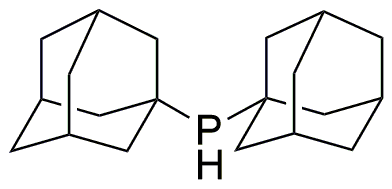Di-1-adamantylphosphine is widely utilized in research focused on:
- Catalysis: This compound serves as a ligand in various catalytic processes, enhancing reaction efficiency and selectivity in organic synthesis.
- Material Science: It is used in the development of advanced materials, particularly in the creation of phosphine-based polymers that exhibit unique properties for coatings and adhesives.
- Pharmaceuticals: Researchers leverage its properties to design and synthesize new drug candidates, particularly in targeting specific biological pathways.
- Nanotechnology: The compound plays a role in stabilizing nanoparticles, which are crucial for applications in electronics and medicine, improving their performance and longevity.
- Environmental Chemistry: It is applied in the study of phosphine derivatives for their potential use in remediation strategies, helping to address pollution challenges.
General Information
Properties
Safety and Regulations
Applications
Di-1-adamantylphosphine is widely utilized in research focused on:
- Catalysis: This compound serves as a ligand in various catalytic processes, enhancing reaction efficiency and selectivity in organic synthesis.
- Material Science: It is used in the development of advanced materials, particularly in the creation of phosphine-based polymers that exhibit unique properties for coatings and adhesives.
- Pharmaceuticals: Researchers leverage its properties to design and synthesize new drug candidates, particularly in targeting specific biological pathways.
- Nanotechnology: The compound plays a role in stabilizing nanoparticles, which are crucial for applications in electronics and medicine, improving their performance and longevity.
- Environmental Chemistry: It is applied in the study of phosphine derivatives for their potential use in remediation strategies, helping to address pollution challenges.
Documents
Safety Data Sheets (SDS)
The SDS provides comprehensive safety information on handling, storage, and disposal of the product.
Product Specification (PS)
The PS provides a comprehensive breakdown of the product’s properties, including chemical composition, physical state, purity, and storage requirements. It also details acceptable quality ranges and the product's intended applications.
Certificates of Analysis (COA)
Search for Certificates of Analysis (COA) by entering the products Lot Number. Lot and Batch Numbers can be found on a product’s label following the words ‘Lot’ or ‘Batch’.
Numéro de catalogue
Numéro de lot/série
Certificates Of Origin (COO)
This COO confirms the country where the product was manufactured, and also details the materials and components used in it and whether it is derived from natural, synthetic, or other specific sources. This certificate may be required for customs, trade, and regulatory compliance.
Numéro de catalogue
Numéro de lot/série
Safety Data Sheets (SDS)
The SDS provides comprehensive safety information on handling, storage, and disposal of the product.
DownloadProduct Specification (PS)
The PS provides a comprehensive breakdown of the product’s properties, including chemical composition, physical state, purity, and storage requirements. It also details acceptable quality ranges and the product's intended applications.
DownloadCertificates of Analysis (COA)
Search for Certificates of Analysis (COA) by entering the products Lot Number. Lot and Batch Numbers can be found on a product’s label following the words ‘Lot’ or ‘Batch’.
Numéro de catalogue
Numéro de lot/série
Certificates Of Origin (COO)
This COO confirms the country where the product was manufactured, and also details the materials and components used in it and whether it is derived from natural, synthetic, or other specific sources. This certificate may be required for customs, trade, and regulatory compliance.


